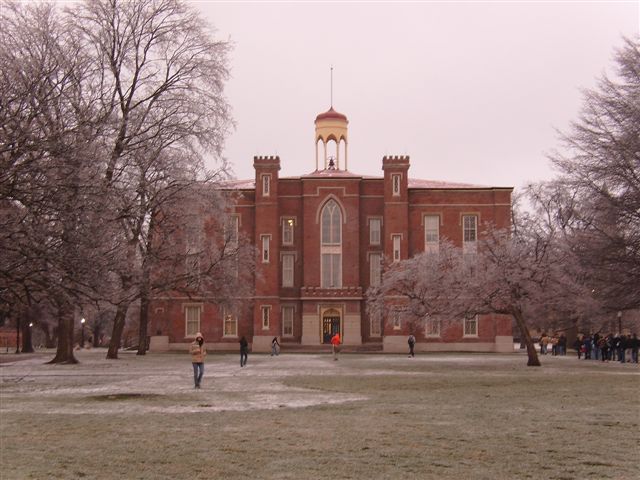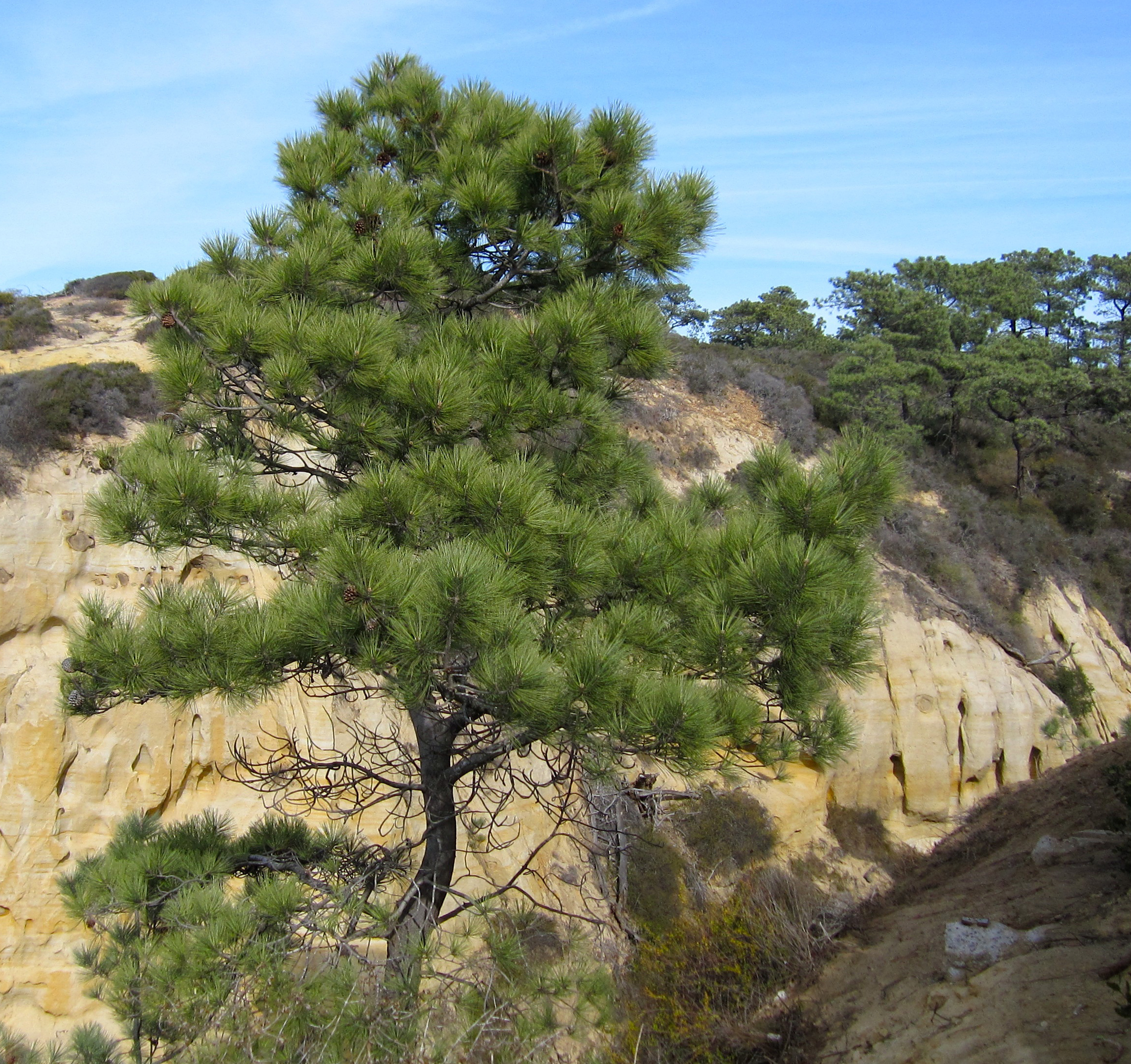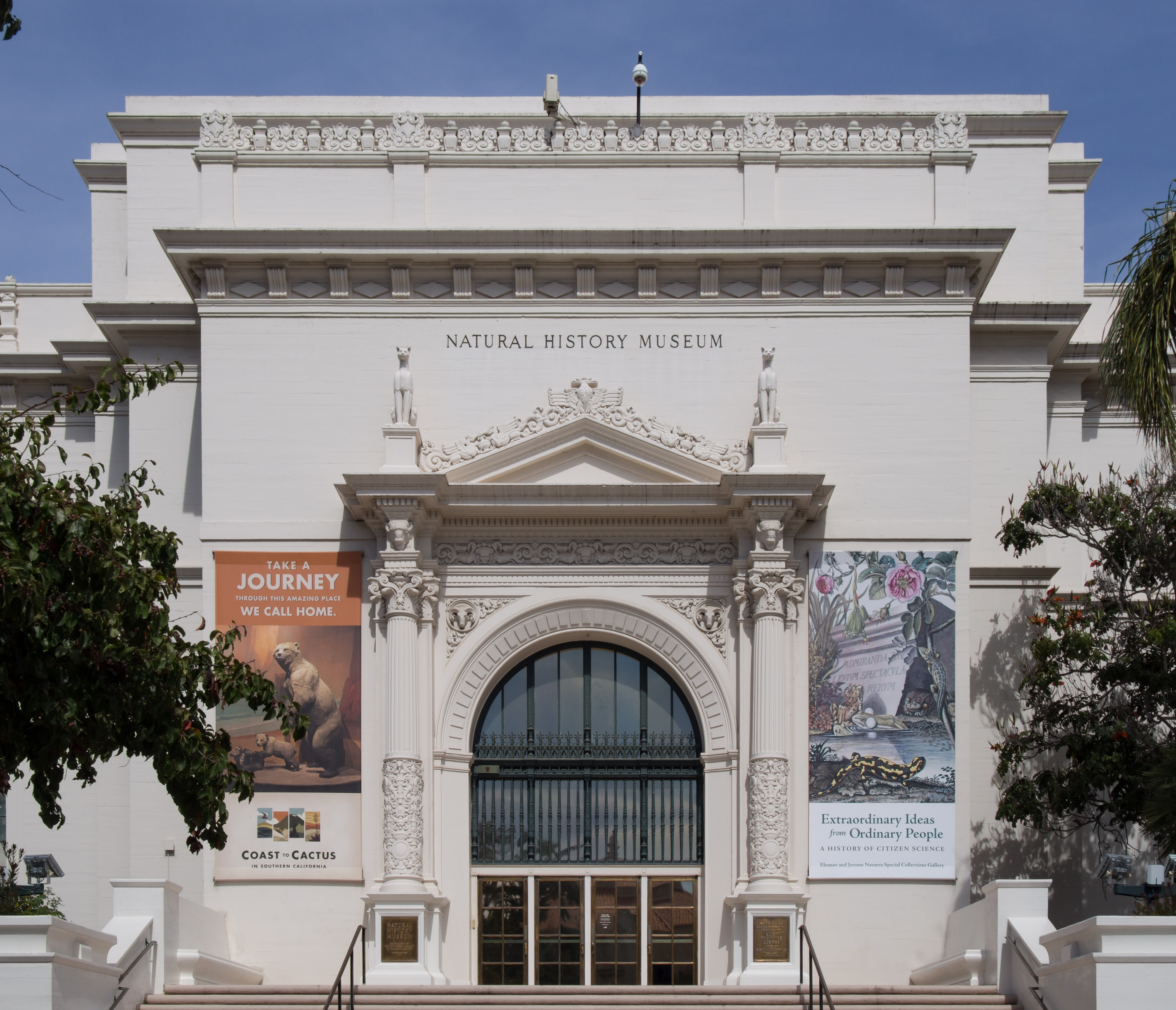|
San Diego Natural History Museum
The San Diego Natural History Museum is a museum located in Balboa Park in San Diego, California. It was founded in 1874 as the San Diego Society of Natural History. It is the second oldest scientific institution west of the Mississippi and the oldest in Southern California. The present location of the museum was dedicated on January 14, 1933. A major addition to the museum was dedicated in April 2001, doubling exhibit space. History The San Diego Natural History Museum grew out of the San Diego Society of Natural History, which was founded on October 9, 1874. The Natural History Society was founded by George W. Barnes, Daniel Cleveland, Charles Coleman, E. W. Hendrick and O. N. Sanford. It is the oldest scientific institution in southern California, and the second oldest west of the Mississippi. In its initial years, the San Diego Society of Natural History was the region's primary source of scientific culture, serving a small but growing community eager for information a ... [...More Info...] [...Related Items...] OR: [Wikipedia] [Google] [Baidu] |
Kate Stephens
Kate Stephens was an American naturalist and the Curator of Mollusks and Marine Invertebrates at the San Diego Natural History Museum from 1910 to 1936. Biography Kate Brown Stephens was born circa 1853 in London, England. Her father, Thomas Brown, was a cab driver; her mother, Mary Tyler Brown, died when Kate was in her late teens or early twenties. Helping to raise her younger brother George while the family lived in the Kensington area of London, Kate is said to have worked at the Natural History Museum. She immigrated to the United States around 1888-1890. She lived for a short time in the city of San Diego, working as a dressmaker, before moving out to the Witch Creek area in eastern San Diego County, where she may have taught school. In 1898, she married ornithologist and mammalogist Frank Stephens and began working with him as a collector and naturalist. Her early field work included collecting butterflies, but her research interest area was shells and fossils, and ... [...More Info...] [...Related Items...] OR: [Wikipedia] [Google] [Baidu] |
Balboa Park, San Diego, California
Balboa Park is a historic urban cultural park in San Diego, California, United States. In addition to open space areas, natural vegetation zones, green belts, gardens, and walking paths, it contains museums, several theaters, and the San Diego Zoo. There are also many recreational facilities and several gift shops and restaurants within the boundaries of the park. Placed in reserve in 1835, the park's site is one of the oldest in the United States dedicated to public recreational use. Balboa Park is managed and maintained by the Parks and Recreation Department of the City of San Diego. Balboa Park hosted the 1915–16 Panama–California Exposition and 1935–36 California Pacific International Exposition, both of which left architectural landmarks. The park and its historic Exposition buildings were declared a National Historic Landmark and National Historic Landmark District in 1977, and placed on the National Register of Historic Places. and Park attractions ... [...More Info...] [...Related Items...] OR: [Wikipedia] [Google] [Baidu] |
Ornithologist
Ornithology is a branch of zoology that concerns the "methodological study and consequent knowledge of birds with all that relates to them." Several aspects of ornithology differ from related disciplines, due partly to the high visibility and the aesthetic appeal of birds. It has also been an area with a large contribution made by amateurs in terms of time, resources, and financial support. Studies on birds have helped develop key concepts in biology including evolution, behaviour and ecology such as the definition of species, the process of speciation, instinct, learning, ecological niches, guilds, island biogeography, phylogeography, and conservation. While early ornithology was principally concerned with descriptions and distributions of species, ornithologists today seek answers to very specific questions, often using birds as models to test hypotheses or predictions based on theories. Most modern biological theories apply across life forms, and the number of scientists who i ... [...More Info...] [...Related Items...] OR: [Wikipedia] [Google] [Baidu] |
United States Navy
The United States Navy (USN) is the maritime service branch of the United States Armed Forces and one of the eight uniformed services of the United States. It is the largest and most powerful navy in the world, with the estimated tonnage of its active battle fleet alone exceeding the next 13 navies combined, including 11 allies or partner nations of the United States as of 2015. It has the highest combined battle fleet tonnage (4,635,628 tonnes as of 2019) and the world's largest aircraft carrier fleet, with eleven in service, two new carriers under construction, and five other carriers planned. With 336,978 personnel on active duty and 101,583 in the Ready Reserve, the United States Navy is the third largest of the United States military service branches in terms of personnel. It has 290 deployable combat vessels and more than 2,623 operational aircraft . The United States Navy traces its origins to the Continental Navy, which was established during the American Revo ... [...More Info...] [...Related Items...] OR: [Wikipedia] [Google] [Baidu] |
Great Depression
The Great Depression (19291939) was an economic shock that impacted most countries across the world. It was a period of economic depression that became evident after a major fall in stock prices in the United States. The economic contagion began around September and led to the Wall Street stock market crash of October 24 (Black Thursday). It was the longest, deepest, and most widespread depression of the 20th century. Between 1929 and 1932, worldwide gross domestic product (GDP) fell by an estimated 15%. By comparison, worldwide GDP fell by less than 1% from 2008 to 2009 during the Great Recession. Some economies started to recover by the mid-1930s. However, in many countries, the negative effects of the Great Depression lasted until the beginning of World War II. Devastating effects were seen in both rich and poor countries with falling personal income, prices, tax revenues, and profits. International trade fell by more than 50%, unemployment in the U.S. rose to 23% and ... [...More Info...] [...Related Items...] OR: [Wikipedia] [Google] [Baidu] |
San Diego Museum Of Art
The San Diego Museum of Art is a fine arts museum located at 1450 El Prado in Balboa Park in San Diego, California that houses a broad collection with particular strength in Spanish art. The San Diego Museum of Art opened as The Fine Arts Gallery of San Diego on February 28, 1926, and changed its name to the San Diego Museum of Art in 1978. The official Balboa Park website calls the San Diego Museum of Art "the region's oldest and largest art museum". Nearly half a million people visit the museum each year. Structure The museum building was designed by architects William Templeton Johnson and Robert W. Snyder in a plateresque style to harmonize with existing structures from the Panama–California Exposition of 1915. The dominant feature of the façade is a heavily ornamented door inspired by a doorway at the University of Salamanca. The Cathedral of Valladolid also influenced the museum's exterior design, and the architects derived interior motifs from the Santa Cruz Hospit ... [...More Info...] [...Related Items...] OR: [Wikipedia] [Google] [Baidu] |
William Templeton Johnson
William Templeton Johnson (1877 – 1957) was a notable San Diego architect. He was a fellow to the American Institute of Architects (AIA) in 1939. Johnson is known for his Spanish Revival buildings, all in San Diego unless otherwise noted: * La Jolla Public Library, now the La Jolla Athenaeum, 1921 * Fine Arts Gallery in Balboa Park in 1932, now the San Diego Museum of Art, 1926 * La Valencia Hotel, La Jolla, 1926 * The San Diego Trust & Savings Bank at Sixth and Broadway, 1928 * The Serra Museum in Presidio Park, 1929 * three buildings (one extant) for the Ibero-American Exposition of 1929, Seville, Spain * Mabel Shaw Bridges Music Auditorium, Pomona College, Claremont, California * The San Diego Natural History Museum, also in Balboa Park, 1932 * The San Diego County Administration Center The San Diego County Administration Center is a historic Beaux-Arts/Spanish Revival-style building in San Diego, California. It houses the offices of the Government of San Diego Coun ... [...More Info...] [...Related Items...] OR: [Wikipedia] [Google] [Baidu] |
Ellen Browning Scripps
Ellen Browning Scripps (October 18, 1836 – August 3, 1932) was an American journalist and philanthropist who was the founding donor of several major institutions in Southern California. She and her half-brother E. W. Scripps created the E. W. Scripps Company, America's largest chain of newspapers, linking Midwestern industrial cities with booming towns in the West. By the 1920s, Ellen Browning Scripps was worth an estimated $30 million (or $388 million in 2020 dollars), most of which she gave away. In 1924, she founded the Scripps Research Institute (TSRI), in the La Jolla neighborhood of San Diego, CA. She appeared on the cover of ''Time'' magazine after founding Scripps College in Claremont, California. She also donated millions of dollars to organizations worldwide that promised to advance democratic principles and women's education. Family history Ellen Browning Scripps was born on October 18, 1836, on South Molton St. in St. George Parish, London. Her father, James Mo ... [...More Info...] [...Related Items...] OR: [Wikipedia] [Google] [Baidu] |
Laurence M
Laurence is an English and French given name (usually female in French and usually male in English). The English masculine name is a variant of Lawrence and it originates from a French form of the Latin ''Laurentius'', a name meaning "man from Laurentum". The French feminine name Laurence is a form of the masculine '' Laurent'', which is derived from the Latin name. Given name * Laurence Broze (born 1960), Belgian applied mathematician, statistician, and economist * Laurence des Cars, French curator and art historian * Laurence Neil Creme, known professionally as Lol Creme, British musician * Laurence Ekperigin (born 1988), British-American basketball player in the Israeli National League * Laurence Equilbey, French conductor * Laurence Fishburne, American actor * Laurence Fournier Beaudry, Canadian ice dancer * Laurence Fox, British actor *Laurence Gayte (born 1965), French politician * Laurence S. Geller, British-born, US-based real estate investor. * Laurence Ginnell, Iris ... [...More Info...] [...Related Items...] OR: [Wikipedia] [Google] [Baidu] |
Guy Fleming
Guy L. Fleming (May 27, 1884 – May 15, 1960) was an American naturalist whose conservation work led to the founding of Torrey Pines State Natural Reserve, now a 2000-acre protected coastal area of La Jolla, San Diego. The Torrey pine, ''Pinus torreyana'', is the rarest pine species in the United States. As district superintendent of state parks for southern California, Fleming also worked to protect major nature preserves that extend from the U.S. border with Mexico to northern San Diego county; these include the natural areas that became Anza-Borrego Desert State Park, Cuyamaca Rancho State Park and Palomar Mountain State Park. As a fellow of the San Diego Society of Natural History, he worked closely with scientists and staff of the San Diego Natural History Museum, leading public nature walks for the museum and lecturing on environmental issues. Biography Born in Nebraska on May 27, 1884, to Georgia Lowd and James Fleming (a carpenter), Guy L. Fleming was twelve when his ... [...More Info...] [...Related Items...] OR: [Wikipedia] [Google] [Baidu] |
Clinton Gilbert Abbott
Clinton Gilbert Abbott (1881 – 1946) was an American ornithologist, naturalist, and Director of the San Diego Natural History Museum from 1922 to 1946. Abbott supervised the construction of the Museum's current building in Balboa Park, expanded research field trips and expeditions, and participated in important conservation efforts in southern California and the Baja California region. He was instrumental in the preservation of the southern California desert area that became Anza-Borrego Desert State Park. Biography The son of American citizens, Clinton Gilbert Abbott was born in Liverpool, England, on April 17, 1881 to Grace Van Dusen and Lewis Lowe Abbott. Abbott's older brother was the writer and freethinker Leonard Dalton Abbott. Abbott received an A.B. degree from Columbia University in 1903 and pursued graduate studies at Cornell University. He married Dorothy Clarke in 1915. From 1910 to 1914, Abbott was vice-president of the Linnaean Society of New York, and fro ... [...More Info...] [...Related Items...] OR: [Wikipedia] [Google] [Baidu] |
.jpg)
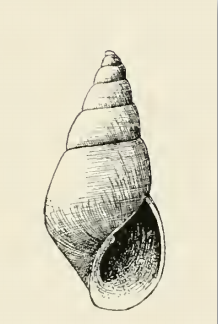
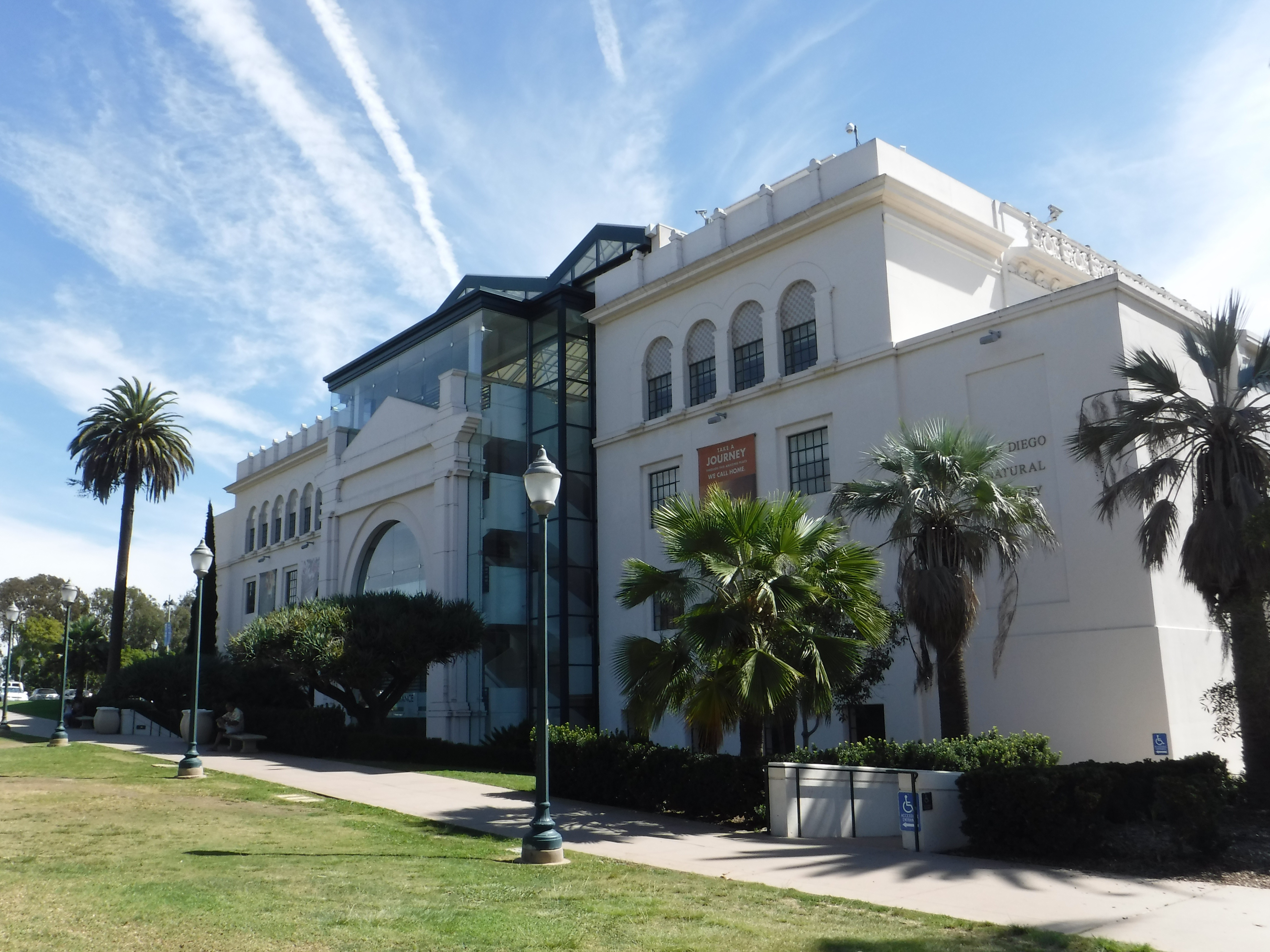
.jpg)


